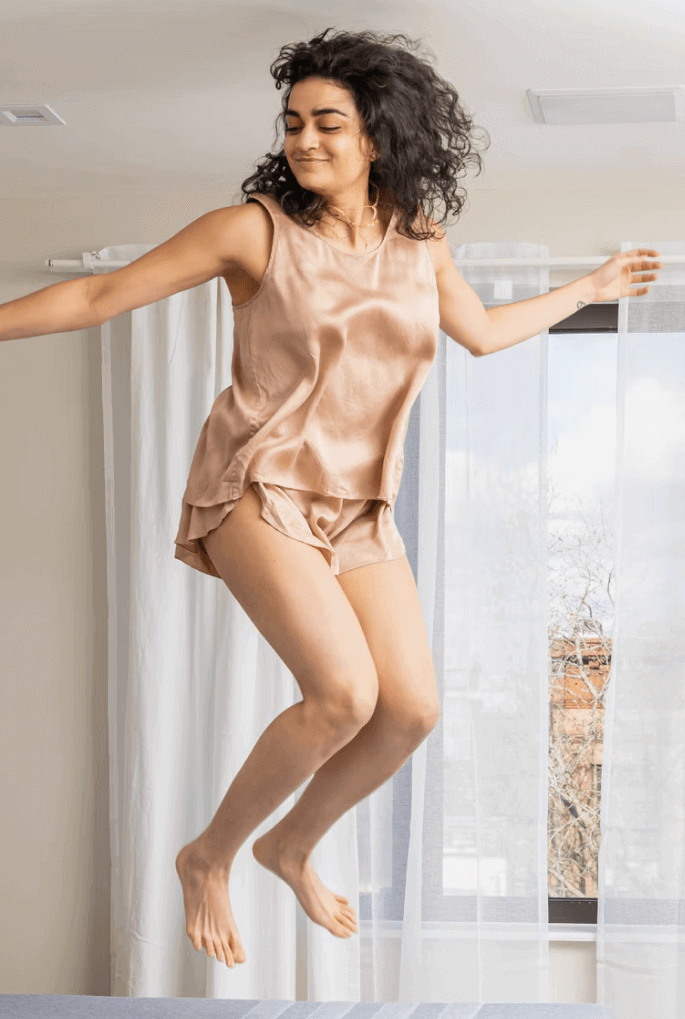Mattress Feel: Comfort Preferences
How to Choose the Most Comfortable Mattress for You
There are two things every mattress must deliver: Spinal alignment and pressure relief. But beyond those two must-haves, many mattress characteristics are preference-based based on your personal needs and likes/dislikes.
Editor's Note: This article is about "Feel" — one of the 3 most important considerations when choosing a mattress. Be sure to learn about the other two – "Fit" and "Features" – in our must-read guide to the 3 F's of mattress shopping.
"Comfort" is a function of how the mattress feels against the surface of your body, and how it responds to your movements. It is what makes you feel cozy and relaxed in your bed (or not), and it is probably the first thing you notice when you lie down. This matters because it's important that your mattress is a place that you look forward to going each night and that you find inherently relaxing. Considerations relating to spinal alignment and pressure relief can sometimes limit you in terms of what Feel characteristics you can get, but typically it's possible to find one that meets those criteria and still skews toward your personal comfort preferences.
Comfort (or "Feel") characteristics are not about what's "best," but rather what are your personal preferences. When most people think about the comfort of their mattress, softness is probably the first characteristic that comes to mind. However, in our Mattress DNA™ framework, there are actually four key elements of mattress "Feel": Softness, Cushioning Depth, Memory Feel, and Bounce. Read on to make sure you understand these characteristics and know what your preferences are on these fronts.
Softness
For mattress shoppers, "softness" and "firmness" can be surprisingly (and unexpectedly) tricky terms. This has to do with both how the usage of these terms has changed over time, and how inconsistently it is used by different manufacturers.
Changing Terminology Over Time
First, some consumers have their own pre-conceived notion of what it means for a mattress to be "soft" or "firm," which can be based on faulty or outdated information. For example, many people think that when it comes to mattresses, the term "firm" means "supportive." And some people, particularly those who bought their first mattress in the 1990's or earlier, even think a "firm mattress" is synonymous with a "good mattress." By the same token, some people may think of a "soft" mattress as one that is saggy, squishy, or unsupportive.
The truth is that manufacturers have changed how they use these terms over the past 25 years. Long ago, the term "firm" was used by manufacturers to describe the supportiveness of a mattress, which typically had to do with the bottom half of the mattress (eg, the spring unit). Today, the vast majority of manufacturers use the term "Firm" to describe the comfort characteristics of a given model, which are a function upper comfort layers of that mattress.
At the same time, sleep habits have also changed significantly. In the past, back sleeping (and even stomach sleeping) were much more common. In these positions, a firmer or medium-firm mattress can often deliver the best spinal alignment. Thus, it was considered conventional wisdom that "firmer" means "more supportive." But today, 70% or more of our readers report that they are predominantly side sleepers. Achieving proper spinal alignment on your side requires the mattress to accommodate the curves of your body, which entails more softness and conformance. Thus, for side sleepers, a firmer mattress can actually be much less supportive. The key take-away is that "firmness" and "supportiveness" are completely separate concepts.
Softness vs. Cushioning Depth
Another source of confusion is the distinction between "softness" and "cushioning depth." The first is how much actual softness it has when you interact with it, and the latter is how deeply you will sink into the mattress and how much it will conform to your curves. These two attributes are typically conflated into one by most mattress manufacturers. Typically, what a consumer thinks of as softness correlates with what we call softness. And what a manufacturer thinks of as softness correlates with what we call cushioning depth.
For some mattresses, softness and cushioning depth can be highly correlated. But for many other mattresses, these characteristics can diverge and cause great confusion for a consumer. Mattresses with quick-responding foams or latex tend to have similar levels of softness and cushioning depth. While mattresses that use denser memory foams, particularly up near the surface, can often have a lot more cushioning depth than they do softness.
Perhaps the clearest example of this would be the original Tempur-Pedic mattresses, especially if you're old enough to remember when these were displayed in stores like Sharper Image and Hammacher Schlemmer. Those mattresses felt almost like concrete when you first interacted with them (eg, if you tried punching them with your fist). But as you lied on them, they softened in response to the heat from your body, and you would eventually sink deeply into them – much more so than on a traditional mattress. GoodBed would classify that as very high Cushioning Depth and very low Softness. However, most manufacturers don't draw this distinction, so they would likely just call that mattress a "Plush."
Softness Choices
Here are the broad categories of softness choices you will see on GoodBed:
- Firm. Also includes “extra firm” and “ultra firm.” While firmer mattresses tend to have less padding, note that not all firm mattresses have minimal padding — some have a stiff padding material, but plenty of it.
- Medium. Also called "luxury firm” or “cushion firm.”
- Soft. Also called “plush” or “ultra plush.” These mattresses tend to have thicker layers of padding composed of soft, compressible material.
Note that many retailers call their softest mattresses "pillow top," because these mattresses have an extra layer of padding, but technically a pillow top can have different degrees of softness, depending on what it's made of and how soft those materials really are. There are even firm pillow tops!
Other Considerations
It is easier to "soften up" a firm mattress than to "firm up" a soft mattress. If you are in doubt, or if you and your partner have different preferences, you should err on the side of purchasing a firmer mattress rather than a softer one. You can always add a mattress topper to one or both sides to soften it up. However, if your mattress isn't giving you good spinal alignment because it's too soft, a firm topper won't fix this. Here's a video that explains why adding a firm mattress topper is usually not a good idea.
Mattresses also tend to soften up naturally as you use them. So a mattress will feel firmer when it's brand new than it will after a few months of use. (Likewise, your brand new mattress may feel firmer than the same model you tried on the showroom floor; yours will soften with regular use.)
Mattresses with thick, soft layers of padding will typically develop body impressions more quickly. The cheaper the quality of the padding material, the faster it's likely to compress and conform to the weight of your body. If you prefer a soft mattress but are concerned about body impressions, consider choosing a firmer mattress with minimal padding and purchasing a mattress topper separately that you can replace a few times throughout the life of your mattress.
Cushioning Depth
Cushioning depth is a term created by GoodBed to refer to how deeply you sink into a mattress. At the extremes, this characteristic can be thought of as the difference between sleeping "in" or sleeping "on" your mattress. Although cushioning depth can sometimes be correlated with softness, this is often not the case. Therefore, it is a separate and independent characteristic. For example, The most common example of where softness and cushioning depth converge is with high-density memory foam, which tends to be very firm upon first contact (giving it very low "softness"), but can then become very conforming as you lie on it for a while (giving it high "cushioning depth"). Likewise, you could have a mattress with a deeply plush quilting on top (giving it lots of softness) but a rigid support layer directly below (giving it minimal overall "cushioning depth").
If you like feel hugged or cradled by your bed, you'll want to look for a bed that has deeper cushioning. If you prefer the sensation of "floating above" your mattress, you'll prefer a bed that has shallower cushioning.
Below: A mattress with a deeply cushioned top

Memory Feel
When you press your hand on the mattress, then remove it, does it spring back to shape immediately or does your hand print remain for a few seconds before the mattress returns to shape? That's what we call responsiveness. For example, memory foam behaves on a spectrum; some foams come back to shape right away, while others take several seconds to fully return to shape.
When you're laying on a mattress, a "slow responding" bed can make you feel like you're sinking into it slowly as your body warms the mattress. Some people really love a slow-responding bed, but others just don't, comparing it to feel like they're in quicksand.
If you like that slow response feeling, memory foam beds are the way to go, but there's a lot of variance among models regarding how much of that "memory foam feel" they have.
Below: Watching memory foam slowly come back to shape

Bounce
Back in the days when all mattresses were made of springs, all mattresses were bouncy. These days, there's a lot more variety. Mattresses that use an innerspring or pocket spring support are most likely to have some bounce. Those that employ memory form, latex, or other foams sometimes have no bounce at all.
At GoodBed, we look at bounce in three ways. Surface bounce (which includes the cover), mid-level bounce (the type of motion you might experience when you change sleeping positions, or during sex), and deep bounce (as you might experience if you plop your whole weight onto the bed at once.
If you prefer more traditional-feeling mattresses, you'll probably want one with an innerspring support core, where coils can push you back up. But if you prefer more stability, or more of a motion-dampening effect, look towards mattresses that have less bounce.












































